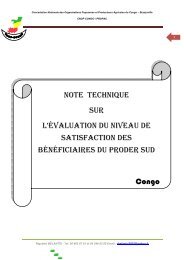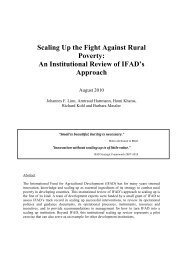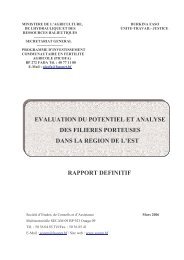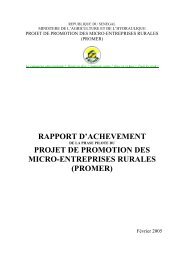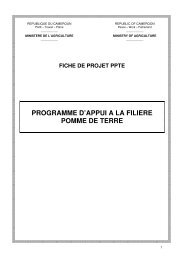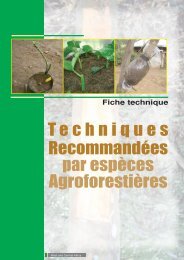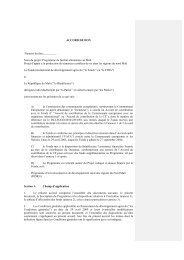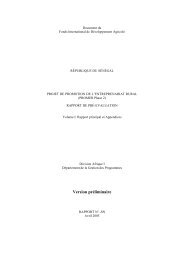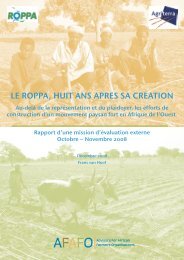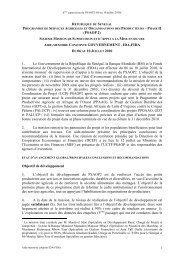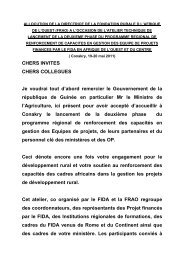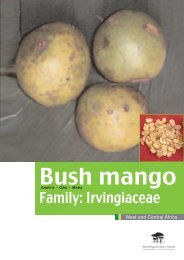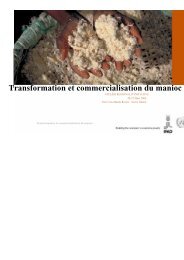CASSAVA OPPORTUNTIES IN NIGERIA - FAO.org
CASSAVA OPPORTUNTIES IN NIGERIA - FAO.org
CASSAVA OPPORTUNTIES IN NIGERIA - FAO.org
Create successful ePaper yourself
Turn your PDF publications into a flip-book with our unique Google optimized e-Paper software.
provide information on the linkages between<br />
different production activities, such as the amount<br />
of produce that is processed into another<br />
commodity (e.g. cassava roots to gari).<br />
Initial data collection activities led to the belief that<br />
each Agricultural Development Programme (ADP)<br />
had enterprise budgets for the primary cropping<br />
patterns in its state. It was thus planned to<br />
develop farm models for each state.<br />
Unfortunately, the visit to 16 ADPs proved<br />
otherwise. Only three of the 16 visited ADPs were<br />
able to provide enterprise budgets that were<br />
representative of the commonly practiced<br />
intercropped activities of the state. Two additional<br />
states provided an enterprise budget on monocrop<br />
activities, but it was felt that these could not<br />
be used to develop representative farm models. It<br />
was suggested by various ADPs that the desired<br />
enterprise budgets be available at the Project<br />
Coordinating Unit (PCU) in Abuja. Unfortunately it<br />
was not possible in the two-day visit to the PCU in<br />
Abuja to collect the desired data.<br />
Copies of the 2000/2001 Advisors Handbook<br />
(Projects Coordinating Unit, 2002) which<br />
contained a compilation of over 40 crop enterprise<br />
budgets collected from 6 states. From the point of<br />
view of farm modelling the data lacked information<br />
on the quantity of inputs (labour and purchased<br />
inputs) and location of the states used to develop<br />
the budgets. Appendix B details how the data was<br />
adjusted to account for this missing detail. With<br />
this adjustment, these data represented the best<br />
and most comprehensive source of cost of<br />
production data we were able to find and formed<br />
the starting point for developing regional farm<br />
models.<br />
The constraints to the model were regional land<br />
availability and producer food consumption<br />
requirements. The regional models are annual<br />
models that maximize gross margins (revenue<br />
minus input and labour expenditures) subject to<br />
minimal farmer consumption and limited by<br />
available land.<br />
The regional models were used to compare four<br />
scenarios against a base scenario. The base<br />
scenario is designed to represent current regional<br />
conditions of land use, food consumption and<br />
agricultural production. Land constraints are used<br />
3<br />
to insure that the base results are similar to<br />
calculated regional averages.<br />
A feature of the model is that it was assumed that<br />
the traditional harvesting of cassava continues<br />
into the second year. The implication for the<br />
annual model is that enterprises containing<br />
cassava require 2 ha of land rather than 1 ha of<br />
land, as do all other enterprises. The four<br />
scenarios are based around two changes. One<br />
change results in cassava being harvested in one<br />
year as opposed to two years. The second is the<br />
adoption of high yielding varieties.<br />
Scenario A assumes yields increase to 15<br />
tonne/ha but harvesting continues into second<br />
year. Scenario B assumes that cassava is<br />
harvested within a single year but yields don’t<br />
improve. Scenario C assumes yield increases to<br />
15 tonne/ha and cassava is harvested in one<br />
year. Scenario D assumes yield increases to 20<br />
tonne/ha and cassava is harvested in one year.<br />
Labelled<br />
Use High<br />
Yielding<br />
Varieties<br />
Harvest<br />
within a<br />
single<br />
year<br />
Base Scenario Base No No<br />
Scenario A Yld 2ha 15 tonne/ha No<br />
Scenario B 1ha No Yes<br />
Scenario C Yld 15 15 tonne/ha Yes<br />
Scenario D Yld 20 20 tonne/ha Yes<br />
The results obtained from these scenarios on<br />
production, area and quantities marketed are<br />
illustrated and discussed throughout the report.<br />
1.4 THE REVOLUTION<br />
The cassava revolution in Nigeria is at its infancy.<br />
This report hopes to describe it in the context of<br />
its current status; new initiatives; future targets;<br />
and future directions. The report <strong>org</strong>anizes the<br />
discussion within six sections: Introduction,<br />
Production, Utilization and Processing, Prices and<br />
Margins, Development Clusters, and The Ultimate<br />
Way Forward. Each section, except for the last,<br />
contains the four subsections: Current Status,<br />
Future Targets, New Initiatives, and The Way<br />
Forward.



